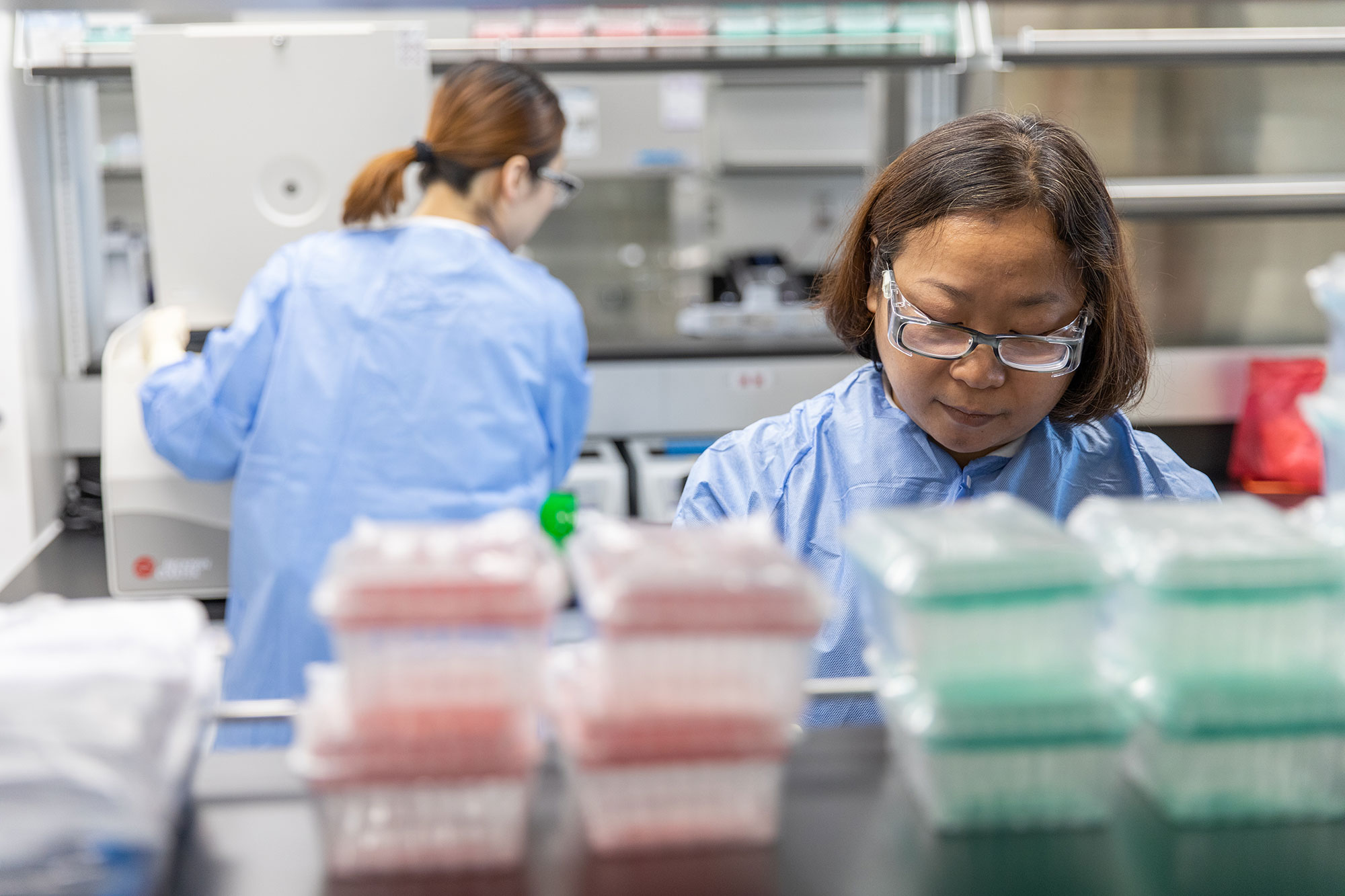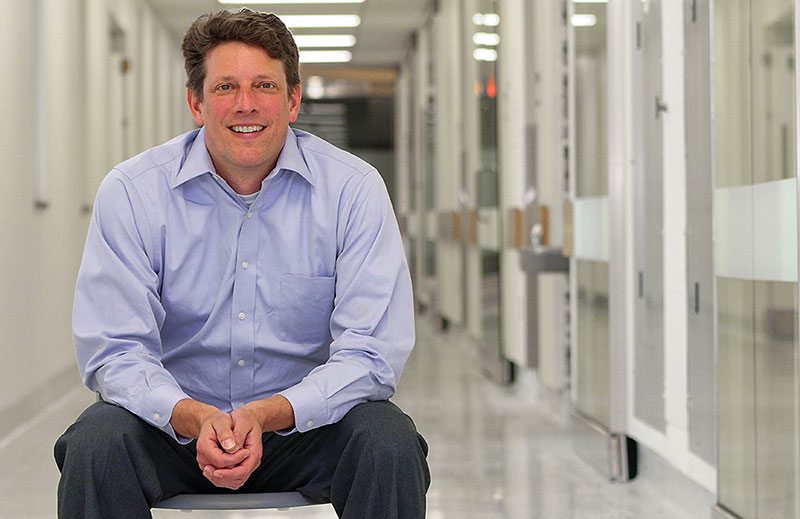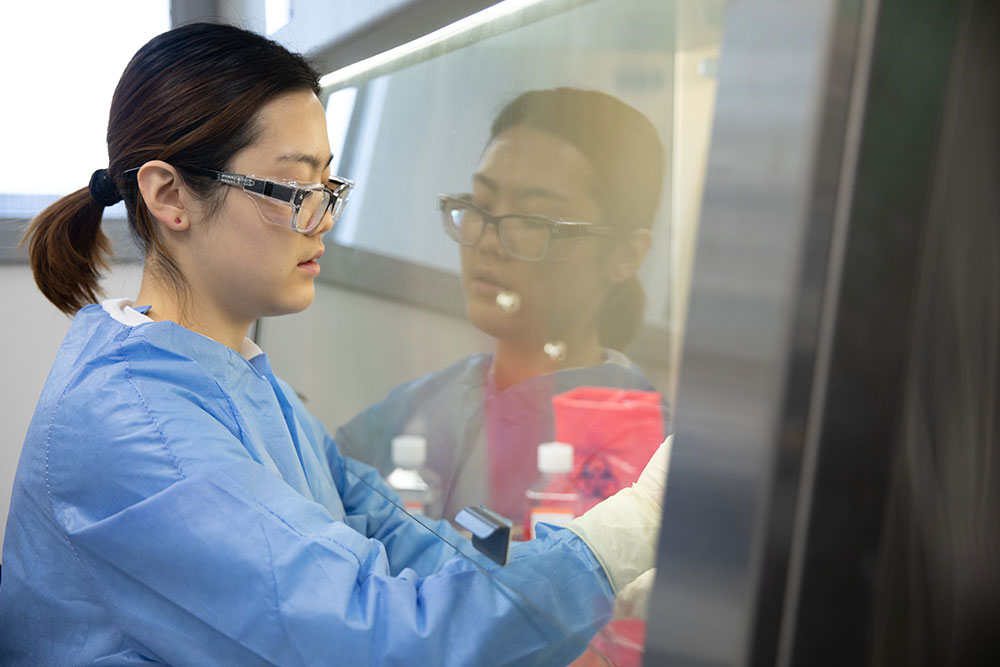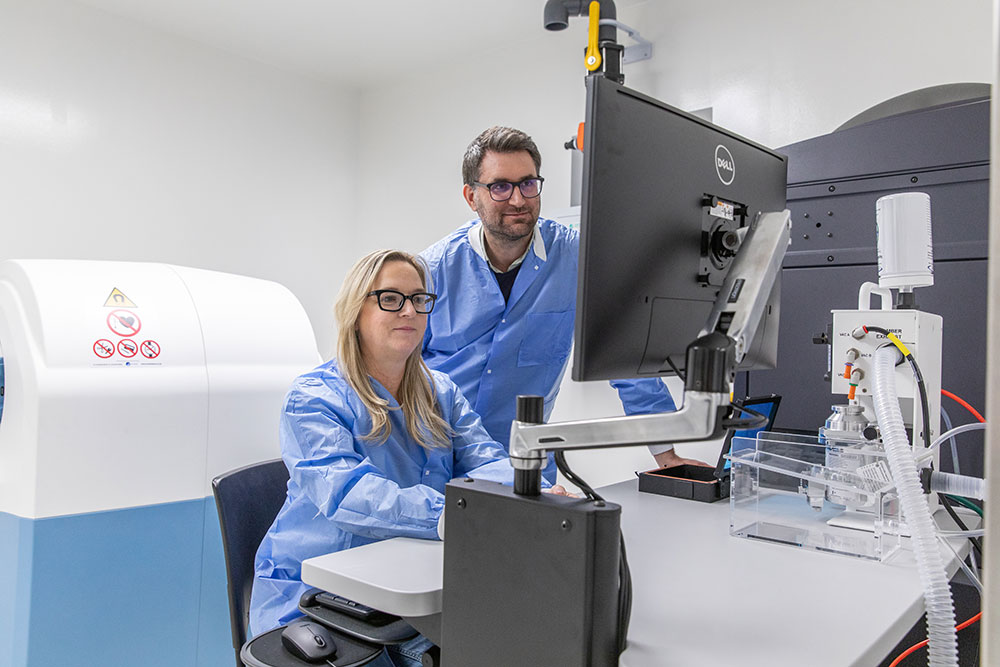
works inside the ImPaKT Facility.
By Jason Winders
When you deal in the microscopically small, it can be difficult to open people’s eyes to the big picture.
“A facility like this is so necessary, it will advance new treatments and new vaccines that we desperately need,” explained Microbiology and Immunology Professor Eric Arts, PhD.
“What we will be able to do here – in Canada, in London, at Western – has the potential to revolutionize medicine.”
That work will originate out of the new Imaging Pathogens of Knowledge Translation (ImPaKT) Facility at the Schulich School of Medicine & Dentistry, a next-generation facility university officials see as essential toward its efforts to become a leader in infectious diseases research and to save lives.
The expected results? Nothing short of groundbreaking research discoveries. Nothing but innovative interdisciplinary collaborations.
Nothing less ambitious than saving or improving millions of lives through cures and treatments for some of the world’s most troubling human illnesses.
“What we will be able to do here – in Canada, in London, at Western – has the potential to revolutionize medicine.”
- Eric Arts, PhD

Known as ImPaKT, the Facility represents a strong line of offence against deadly bacteria and viruses threatening millions around the globe, including HIV, West Nile, tuberculosis, Staph A and Zika.
But a special kind of research requires a special place. Virus and bacteria research requires dedicated and specifically designed facilities, equipment and processes – meaning that conventional imaging technologies available to those who study, for example, cardiovascular disease or cancer, have not been available to pathogen researchers. Far too risky.
Instead, pathogen researchers have had to conduct key research by drawing blood and testing for disease biomarkers: intermediary steps by which they can infer important information about how viruses and bacteria work in the body. “For our work, that is, basically, just an educated guess as to what the impact of the disease is,” said Arts, Canada Research Chair in HIV Pathogenesis and Viral Control.
This new facility – which includes, in one room alone, four state-of-the-art imaging machines – enables researchers to examine pathogens and the body’s immune system at work in fighting them. Scientists can use these technologies to understand the pathogen’s effect on the body, the body’s response to treatment and how treatment interacts with the immune system.
“We are now able to study in real time how a pathogen can cause disease in the entire body, specifically organs and tissue systems, right down to the microscopic level,” Arts explained.

“A facility like this is so necessary, it will advance new treatments and new vaccines that we desperately need.”
- Eric Arts, PhD
Across its 7,000 square feet, the ImPaKT Facility is made up of Level P2+ and Level P3 containment facilities (The P stands for Pathogen or Protection biosafety safeguards). Level 3 designation represents pathogens that are more easily transmitted, such as tuberculosis and West Nile. Level P2+ facilities would handle pathogens more difficult to transmit, such as hepatitis and HIV.
Because of these designations, significant precautions are in place to protect against and prevent contamination. Traffic flow is restricted, floors and ceilings are seamless with rubberized paint for ease of disinfection, ventilation systems have double redundancies that ensure safe airflow. Researchers in the Level 3 lab must wear gowns, Tyvek suits, gloves, boots, safety glasses and N95 respirators.
The Facility includes biosafety labs, decontamination suites, small-animal housing, a Polymerase Chain Reaction clean room and an ultra-speed centrifugation suite.

“What it means is that many experiments we could never have done before using imaging can now be possible – pretty much every experiment that will happen there is going to be something new when it begins.”
- Paula Foster, PhD
But the imaging area is what makes the Facility special in the world.
There, animal models can be imaged in real time in a single suite that contains a magnetic resonance imaging (MRI), positron emission tomography (PET) scanner, computed tomography (CT) scanner and a bioluminescence imaging system.
“It’s unique to have all of that imaging equipment within a containment facility, in fact it’s the only place in Canada and one of very few in the world,” Medical Biophysics Professor Paula Foster, PhD, explained. “What it means is that many experiments we could never have done before using imaging can now be possible – pretty much every experiment that will happen there is going to be something new when it begins.”

But building the ImPaKT Facility, where this groundbreaking research will take place, involved one of the most complex construction and engineering projects ever undertaken in university history, said Mike McLean, Director (Planning, Design & Project Administration), who served as project lead.
“There is a lot of pride in this facility,” McLean said. “Complex research labs are really dense.”
Indeed, ImPaKT is unique and custom from top to bottom and inside and out.
A decade ago, Schulich Medicine & Dentistry established a vision to become “a global leader in optimizing life-long health through innovations in research, education and active engagement in communities.” Already a national leader, as well as one of Canada’s oldest medical schools, the School charted an audacious course with an eye toward advancing human health locally, regionally and globally.
Today, the School houses some of the finest educators, clinicians and researchers in North America – all members of teams working in a number of vital areas of human health, including infectious diseases.
To maximize a facility like ImPaKT, collaboration is key. The Facility involves contributions from more than a dozen scientists and researchers from across Western. It will also draw in collaborations with industry, biotech and pharmaceutical companies across the city and across the world.
“It’s hard not to be excited about the new opportunities for research, new opportunities for collaboration that this facility provides. New insights. New treatments. This is going to be an incredible, one-of-a-kind facility.”
David Litchfield, PhD, Vice Dean, Research & Innovation.
“The Facility creates this incredible collaborative environment where we need the pathogen experts and imaging experts,” said Richard Gibson, Director of the ImPaKT Facility. “We want to create partnerships that haven’t existed yet because they haven’t been possible. It will allow us to answer questions that we couldn’t answer before.”
It’s this combination of innovative researchers using cutting-edge equipment and daring to ask big questions that David Litchfield, PhD, Vice Dean, Research & Innovation at Schulich Medicine & Dentistry, says will lead to novel discoveries and advancements at the School.
“Recruiting the best scientists and giving them state-of-the-art tools to do the research, there is no smarter course. Tools and talent. So important,” he said.
In the end, Arts explained, ImPaKT could be the difference-maker in improving millions of lives around the globe.
“This facility advances Western’s position as a leader in infectious diseases research,” he said. “It opens up the potential to develop vaccines and new treatments to help eradicate some of the world’s most devastating illnesses.”
Litchfield echoed, “It’s hard not to be excited about the new opportunities for research, new opportunities for collaboration that this facility provides. New insights. New treatments. This is an incredible, one-of-a-kind facility.”